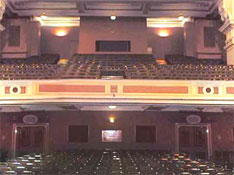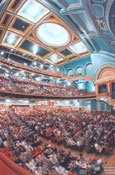


| Eurythmics on TV |
Concerts venues - Tourists Last Laugh Tour -
1980 |
Return to Biography |
 |
 |
 |
| February 14 | Ipswich (UK) | Gaumont |
|
| ||
| The Ipswich Gaumont (Regent) opened in 1929 as a cine-variety hall. At 7.00pm on Monday November 4th, the entrance doors of the new Regent, Ipswich opened and into its spacious foyer crowded nearly 2,000 Ipswich people who had come to witness this momentous occasion.The popularity of cinema in the halcyon days of the 1930's and 40's was so great that another cinema in Ipswich, The Ritz, was opened in 1937. But the advent of television in the 1950's proved a testing time for cinemas up and down the country and even the highly successful Regent, by now known as the Gaumont, did not survive intact. To allow the cinema to become more profitable, the restaurant was closed down and replaced by the Victor Sylvester Dance Studio. In the late 1950's the 'pop' music phenomenon exploded. Buddy Holly and the Crickets started off the craze at the Gaumont and since then thousands of international artists have graced the theatre's stage including the Beatles, Tina Turner, The Bay City Rollers, Tom Jones, Chris Rea, Status Quo and many of today's top artistes. The theatre was re-launched in September 1991 after Ipswich Borough Council successfully negotiated the ownership from the Rank Organisation and NCP. Today, Ipswich Borough Council continue to fund the running of the theatre as part of its arts and entertainment portfolio that also includes the Corn Exchange and Ipswich Film Theatre. | ||
| February 15 | Birmingham (UK) | Odeon |
 | ||
| February 16 | Manchester (UK) | Apollo |
  |
||
| The Manchester Apollo was originally built as the ABC
Cinema, Ardwick in 1930. It was designed by architects Peter Cummings,
Alex Irvine and R Gillespie Williams. Its original purpose was as a cinema
and variety hall. It was opened by famous 1930's actress Margaret
Lockwood. The venue has seen its fair share of famous faces over the years
and has hosted concerts for many of the leading contributors to music in
the last few decades. Artists such as The Beatles, David Bowie, Queen and Bob Dylan have all played at the Manchester Apollo. In the past four years, the venue has seen multiple sell out concerts from many of today's biggest names in music: The Verve, Robbie Williams, Steps, The Charlatans, Ocean Colour Scene and Paul Weller. Recently the Manchester Apollo has shown its popularity in many ways. It was rewarded a Silver Award by top industry magazine "Live" in 1997, and in 1998 it was placed sixth in the NME's readers poll of their favourite live venues, with the other places being dominated by London venues. It has also become very popular with bands and many believe that it is the best venue in the North-West. Manic Street Preachers' Nicky Wire placed it in his top three venues to play in recently. Capacity: 2693 (fully seated shows) 3500 (standing downstairs, seated upstairs shows) | ||
| February 17 | Blackburn (UK) | King Georges Hall |
   | ||
| August, 1914 brought construction work to an end. The building
which was used as a Red Cross Hospital during the First World War, was
rapidly completed once hostilities ceased. Lord Derby performed the
opening ceremony on October 21st, 1921. The 3,500 seat concert hall with
its war memorial organ was known as King George's Hall. Built in the
classical style of stone from Butler's Delph in Pleasington, the Blakey
Moor front has Corinthian columns at first floor level over a three arched
entrance which leads into a Spacious entrance hall, with on each side a
staircase made from Huddersfield stone. There are carved figures
representing War and Peace above the two side entrances too one of the
smaller halls. (Windsor Suite formerly known as Assembly Hall). The building was one of the first in Blackburn to have air conditioning (ozone air system), was electrically lit from the start, and of fireproof construction throughout. The overall dimensions of King George's Hall were 150ft by 104ft, a height of 50ft, and seating for 3,500 on a flat auditorium floor and a raked U-shaped balcony | ||
| February 18 | Sheffield (UK) | City Hall |
   |
||
| Sheffield City Hall is a building containing several venues, ranging from auditoria to a ballroom, in Sheffield, England. The large hall dominates Barkers Pool, one of the most-used squares in Sheffield, containing the city's War Memorial. The City Hall was designed in 1920 by E. Vincent Harris, but was not completed until 1934. It is a neo-classical building with a giant portico. The largest hall in the building, seating 2,800 people, is commanded by a grand dome. | ||
| February 19 | Bridlington (UK) | Spa Royal |
|
| ||
| The Spa Theatre was built in 1896 by S. Dyer, but was rebuilt in 1907 following a fire. This is the theatre that is still in use today. It has a seating capacity of 1031. You can visit the Spa Theatre website here... | ||
| February 21 | Aberdeen (Scottland) | Fusion Ballroom |
|
| ||
| February 22 | Edinburgh (Scottland) | Odeon |
|
| ||
| Opened 1930, seating 2000, as the New Victoria. Renamed
Odeon in 1965. Stage was made deeper in 1978. Tripled in 1982, additional
2 screens later added on stage area. Listed Grade B. Much original decoration remains, especially in and around Screen 1. Subdivision was carried out in a reversible manner. Closed 2003; building has been sold to property developer. The future is not looking good... three plans for redevelopment have been put forward, none of which involve retaining the interior. August 2004: Building was used as a Fringe venue called Pod Deco - each the screens was a separate stage for comedy and drama. Temporary seating was used, and in Screen 1, a new lighting rig was suspended from the ceiling. Curtains hid the lack of screen. What was especially nice was the re-opening of the cafe area as a bar, and being able to sit out on the balcony on a summers evening having a drink. The Pod people expressed an interest in running the building as an all-year round venue, however plans for demolition are well advanced, so it remains to be seen if anything can be done to save the place. | ||
| February 23 | Newcastle (UK) | City Hall |
|
| ||
| Opened in 1929, Newcastle City Hall is one of Newcastle's most unique and prestigious venues. Its Old World charm and stunning architecture, including sandstone walls and pillars, marble staircases, clocktower and sweeping ballroom, is reminiscent of a bygone era. With five main function rooms including a Concert Hall, Newcastle City Hall plays host to civic receptions, community gatherings, weddings, national and international conferences, trade shows, seminars, corporate meetings, product launches and social functions. | ||
| February 24 | Glasgow (Scottland) | Apollo |
|
| ||
| As an institution, the Apollo is unique in the memory of Scottish music, dance hall and cinema fans over the age of 30 and for many, the venue situated at the top of Renfield Street from 1927 to 1985, is closely associated with Glasgow's history. The Apollo provided artists with the opportunity to perform in front of one of the most discerning and demanding audiences in the world. Such was its reputation that one relieved act is reputed to have printed T-shirts saying: "....I played the Apollo and survived". | ||
| February 25 | Leicester (UK) | De Montfort Hall |
  | ||
| The De Montfort
Hall is a music and performance venue in Leicester, England. It is
situated near Victoria Park, and is named after Simon de Montfort, Earl of
Leicester. It has a capacity of about 2,000 seats. The Philharmonia Orchestra has been resident at the hall since 1997. | ||
| February 26 | Bristol (UK) | Colston Hall |
|
| ||
| The present Colston Hall is the fourth to have stood
on the Colston Street site successively occupied by the Priory of White
Friars (Carmelites), Sir John Young's Great House and Edward Colston's
Boy's School. Since the opening of the first hall in 1867, the Grade II
listed front facade has remained the same with its imposing Victorian
columns and arches, and Bristol Byzantine brick and tile work. The auditorium within however, has been rebuilt four times and the current hall was opened in 1951. The previous Hall had escaped the Bristol Blitz of the second world war, only to be tragically burnt down a few months before the end of the war in 1945. A simple pencil entry in the hall diary on February 5th that year states, "Hall destroyed by fire". A new Concert organ built by Harrison and Harrison of Durham was installed in 1954 to complete the hall. The auditorium has remained much the same since the 1950s. The shallow platform was extended in the 1960s and a lighting grid was intalled in 1982 to fly lighting systems for pop shows. Since 1999 the seats in the front half of the stalls can now be easily removed to make a standing area for pop show audiences who prefer to dance. | ||
| February 27 | Southampton (UK) | Gaumont |
   | ||
| The early days of the Empire, the threat from the
Second World War that left the theatre damaged and pictures of some of the
oldest programme covers from the 1930s. From 1950 the theatre was renamed
the Gaumont, and began a revival in live entertainment, from Max Miller to
Margot Fonteyn. From the Beatles to the Rolling Stones, to Elton John and
Queen, the Gaumont was rocking through the 60s, 70s and early 80s. The
Gaumont shuts its doors for the final time in January 1986, but is saved
from permanent closure. New Beginnings: the Mayflower is chosen as the new
name for the theatre which is opened on February 24, 1987. Capacity: 2194 seats. | ||
| February 28 | London (UK) | Hammersmith Odeon |
|
| ||
| Eurythmics on TV |
Webmaster: eontv@online.fr |
© 2005 |